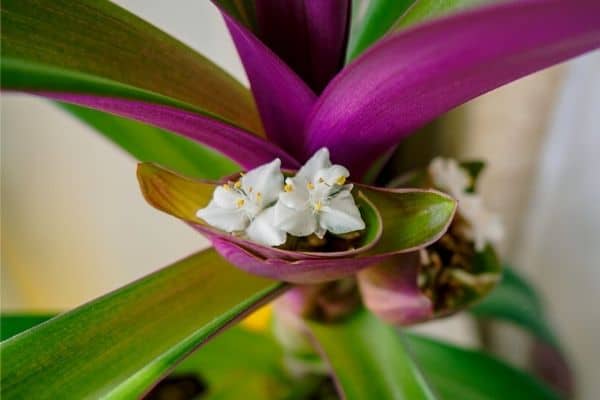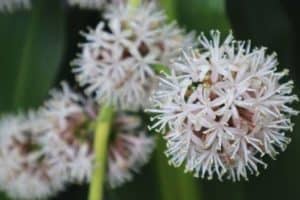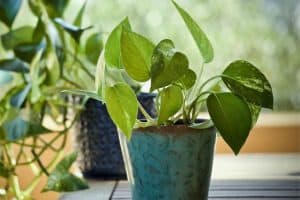Boat lilies (Tradescantia spathacea) are colorful, low maintenance plants that can be grown outdoors in a flower bed or indoors as houseplants.
They have colorful, striped evergreen foliage that can be green, pink, purple or gold depending on the variety.
In this article I’ll give you some helpful tips to grow beautiful boat lily plants.
This post contains affiliate links. Please read the disclosure for more info.

Boat lily flowers look like they’re sitting in a little boat created by the bracts, which is how they get their name.
Other names for boat lilies include Moses in a Boat, Moses in the Cradle, Cradle Lily, Rhoeo, Moses-in-the-Bullrushes, Spiderwort and Oyster plant. [1]
Boat lily varieties
There are many different varieties of boat lilies and most species are native to Mexico and Central America.
Some of the most popular varieties include:
Stripe-me-pink – has beautiful green and pink striped foliage
Rhoeo ‘Gold’ – has gold leaves with thin green stripes
Dwarf purple – makes a beautiful ground cover and has green and purple leaves
HOW TO GROW BOAT LILY PLANTS
Climate
Boat lilies love warm, humid weather and grow best in tropical or subtropical areas.
Outside the tropics, they can be grown indoors if there’s enough warmth and humidity available.
A small humidifier will help to increase the humidity in your plant room and keep your plants happy.
Boat lilies aren’t frost tolerant so if you live in an area with frosts and cool winter temperatures you can plant them in containers and move them indoors during the cooler months.
Soil
Boat lilies are susceptible to root rot so they need well draining soil.
When planting boat lilies in containers it’s best to use a potting soil that drains quickly so that the roots are not constantly wet.
If you’re planting boat lilies in the garden, avoid low lying areas that can become waterlogged.
Sunlight
Boat lily plants grow well in full sun or partial shade.
Afternoon shade is recommended in areas with hot summer temperatures.
Place indoor boat lily plants near a bright window.

Watering
Boat lilies are drought tolerant plants and they grow best when the soil is allowed to dry out in between waterings.
Check the soil with your finger before watering to make sure the top layer of soil is dry.
Pruning
Pruning boat lily plants each year in spring helps them to grow bushier.
You can also cut them back if they’re getting too big for your garden.
Always wear gloves when you’re working with boat lilies because they can irritate your skin.
Fertilizing
Fertilize the plants every month during spring and summer when they’re actively growing.
Use a balanced liquid fertilizer that will give them all the nutrients they need to thrive.
Propagating Boat Lilies
Offset propagation
The easiest way to propagate boat lilies is by potting up the offshoots that grow from the base of the plants.
You can remove the offsets by carefully removing the plant from the pot and separating the offsets from the parent plant.
Make sure each offset has a few roots attached.
Pot them up in new pots and repot the parent plant.
Stem cuttings propagation
Stem cuttings are another way to propagate boat lilies and they can be taken from the plants at any time between spring and fall.
Cut sections of the stem about 3 inches (8 cm) long and place them in a pot with starter mix.
After a few months you can move the cuttings to a larger pot or plant them out in the garden.
You can also put the cuttings in a jar of water until roots form and then pot them up.
Seed propagation
You can also grow boat lilies from seed by collecting the spent flowers.
Hold the flowers above the soil and gently crush them to release the seeds.
If you have boat lily plants indoors you’ll need to move them outdoors for a short time to allow the bees to pollinate the flowers so they’ll produce seeds.

Pests and diseases
Boat lilies love humid conditions which means they are susceptible to fungal conditions like root rot and leaf spot.
If you notice any leaves that are affected you’ll need to remove as many of the damaged leaves as possible and treat the plant with a fungicidal spray.
Boat lilies can also be affected by pests including mealy bugs and spider mites.
You can get rid of these pests by spraying the leaves with insecticidal soap.
Common questions
How big do boat lilies grow?
Most varieties grow to about 50 cm high and 50 cm wide.
Leave at least 12 inches (30 cm) in between plants to allow for spreading.
Are boat lilies frost tolerant?
Boat lilies are native to tropical regions so they’re not frost tolerant.
If you live in an area with winter frosts you can plant them in containers and overwinter them indoors.
Are boat lilies toxic for pets?
Boat lilies produce sap which can cause skin rashes, stinging and itching in pets and humans.
So there are my tips for growing beautiful boat lily plants.
With the right care you can enjoy these colorful perennial plants in your garden or indoors for many years to come.
RELATED ARTICLES
Have you tried growing boat lilies? Let me know in the comments below.
Are you on Pinterest? I have boards dedicated to Home Gardens and Indoor Plants that you may enjoy. You can also find me on Facebook.






Hi Kelly. Thanks for this article. It is really helpful.
I am trying to grow my boat lily in a wall-mounted clay (terracotta?) planter. It’s leaves are drooping, and some of the smaller ones are simply dying. Some more info:
1. The pot is around 5″-6″ deep, and the way it is placed, it gets indirect sunlight during the day and direct sunlight for about 2 hours in the evening. I am from Pakistan, so it is quite hot and humid here (40 to 45 Celsius).
2. I used to water it frequently at a schedule, but learnt later that you are supposed to water it only one the top soil dries out. Taking care of it now.
3. I also added some fertilizer recently. The droopiness increased after that. Prior to that, they weren’t doing bad, but we’re not growing as fast as I’d thought they should. I’ve had them for about 2 months. Am I being impatient with their growth?
4. I’ve also have them in another wall-mounted planter that receives more sunlight. They are doing fine (as in, not droopy), but not growing in size as such. I’ve had them for about 6 weeks.
Kindly let me know if you think I should at further info.
Hi Salman, sorry to hear that your plants are drooping. Terracotta pots dry out very quickly so I think that may be the problem, especially as it’s so hot there. Maybe you could try moving one of the plants to a different type of pot and see if that helps?